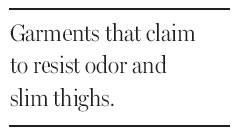View
Clothes are made to multitask for a busier, pricier world
Updated: 2011-06-19 07:46
By Eric Wilson (New York Times)

Whatever happened to clothes that were just clothes? Now there are toning shoes, gut-reducing underwear, parka drawstrings that double as earphones, and leggings laced with caffeine, supposedly to help slim your thighs.
Clothes, like everything else in modern life, are multitasking.
At the Uniqlo store in Manhattan, window displays promote something called "UV Cut"; inside, posters show the actress Charlize Theron in clothes that purport to be infused with "wearable sunscreen."
"Filter ultraviolet rays in style," proclaim the labels on cotton T-shirts, linen trousers and, paradoxically, thick hooded sweatshirts with a UPF factor of 50 to block out solar ultraviolet radiation. In Uniqlo's men's department, "anti-odor" polo shirts and "silky dry" perspiration-wicking T-shirts say they are "so dry and comfortable, it feels like you're wearing nothing."
Along with the price tags on most of the store's merchandise, there are tags announcing all manner of technical advancements in textile design. Some can be confusing, like a dress shirt that has a tag describing its "easy care" and another that warns: "Fingernails, protruding items, and items such as fittings on jewelry and bags can cause snagging. Please use care."
Becky Worley, an American TV correspondent, recently held a pair of caffeine-laced leggings to her nose on the show "Good Morning America" and said: "They don't smell like coffee. They actually smell a little fruity."
Styleite, a fashion blog, followed with a post that declared, "No, caffeine-laced legwear will not help you lose weight." Those leggings, which cost $50, are selling like crazy.
Functional fashion has become something of a buzzword in the apparel industry, and that is partly the result of marketing aimed at keeping consumers engaged with disposable clothing. It is also the result of a need to justify higher prices caused by the rising cost of raw materials like cotton and wool. That is not to say the UV-protective garments, for instance, are not effective, though their potency typically lasts for only 30 washes.
Innovations might be forcing clothes, like cellphones and cars, to become smarter.
"Today, fashion has a job to do," said Heather Thomson, the founder of Yummie Tummie, a line that includes a T-shirt made with a panel of polyester and spandex to hold in your gut.
"We're busier and busier, and we need versatility in things," Ms. Thomson said. "But there's a lot of kitsch on the market, too. We have to be careful as consumers about what is actually good for us and what is just marketing." It might be nice to see a jacket infused with an afternoon snack, or jeans that suggest clever things to say on Twitter. Manufacturers are also thinking big.
At Eastern Mountain Sports, near Uniqlo, a polyester polo shirt wicks away perspiration, dries quickly, resists odor and has a UPF factor of 30+. But it was the tag that stood out.
"I'm effortlessly cool," it says.
The New York Times

Specials

Mom’s the word
Italian expat struggles with learning English and experiences the joys of motherhood again.

Big win
After winning her first major title, Chinese tennis star could be marketing ace for foreign brands

Markers of memories
Axe comes down on historical buildings as part of Harbin government’s baroque programs